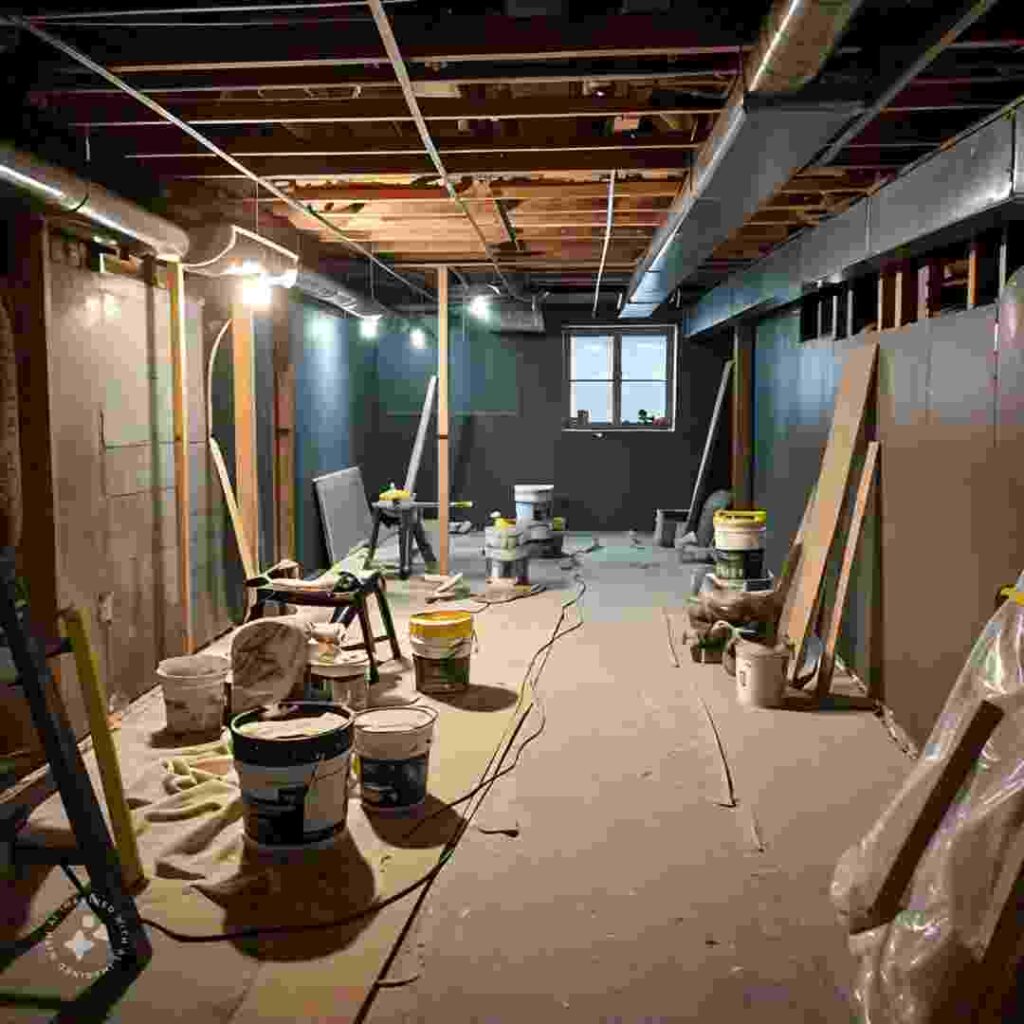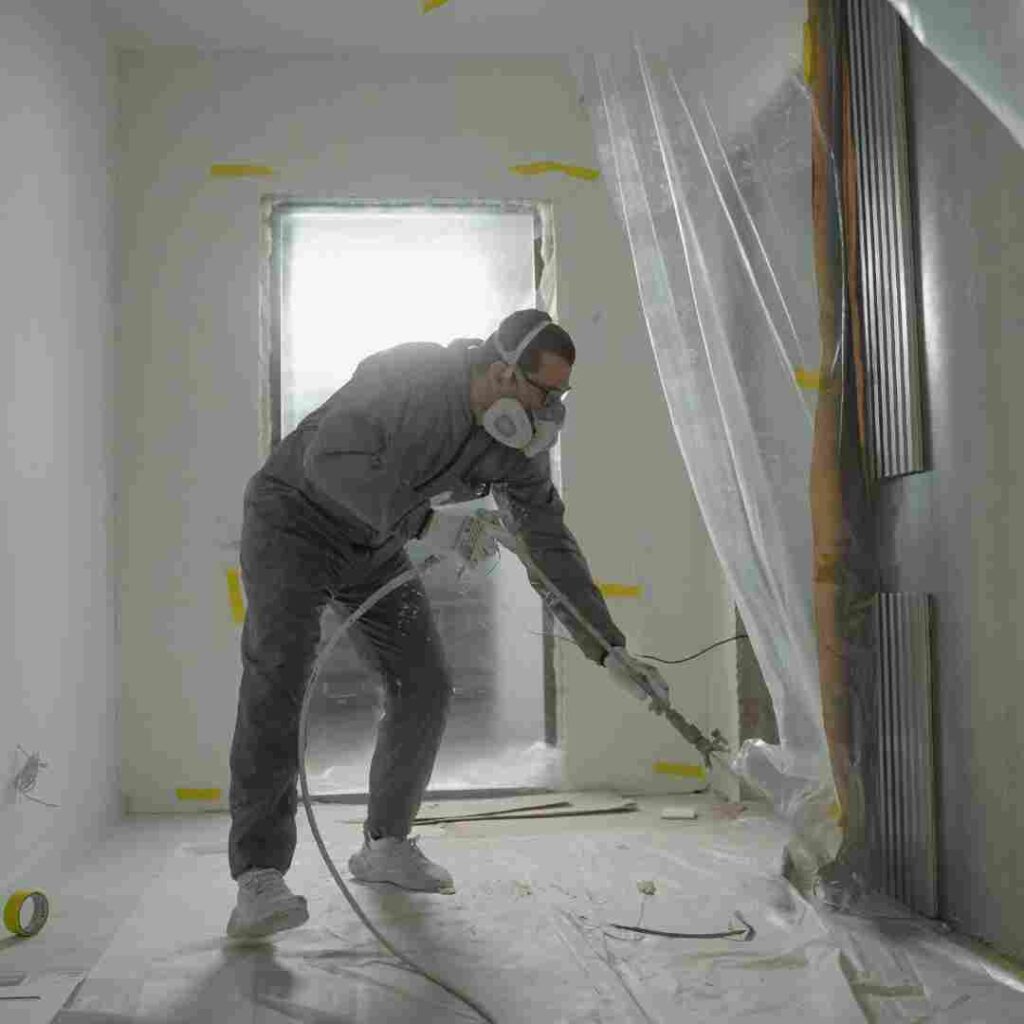Table of Contents
In the USA, making the most of every square foot of living space is becoming more and more popular, especially as more homeowners look to maximize the value of their properties. One space that is often ignored is the home basement.
Home basements usually need to be used more in American homes, as they are allocated primarily for storage. But you can turn your basement into a useful and valuable room with a little imagination and work.
Let’s discover the fundamental stages of remodeling your home basement, from organizing and resolving typical challenges to selecting the ideal layout and accents.
How to Renovate Your Home Basement?
Planning Your Basement Renovation
1. Analyze Home Basement’s Potential
It is important to evaluate your basement’s existing condition before beginning any restoration projects.
To figure out how much space you have to work with, carefully review the area and arrangement.
Check the structure’s foundational stability, looking for any indications of moisture, cracks, or other problems that should be fixed before renovations start.
- In the USA, it is also necessary to take consideration local building rules and permission requirements.
- Make sure you are aware of the unique restrictions that apply to home basement renovations in your state and city.
- Getting the required permissions helps you avoid future penalties or issues in addition to verifying that your restoration is up to order.
2. Define the Purpose of the Renovation
Consider your planned usage of the home basement after you have evaluated it. The entire renovation procedure will be directed by this choice.
Converting a basement into a home office, gym, entertainment space, or guest suite is popular idea.
- Think about your lifestyle and the newest house design trends in America while choosing the purpose.
- In this case, it could be a wise decision to convert your basement into a peaceful, pleasant workplace given the rise in individuals working from home.
- If you like to throw parties, adding an entertainment room can be a terrific idea.
- It will be more entertaining and functional if you design it to suit your requirements and interests.
3. Budget and Financing
An essential first step in any renovation job is creating a budget.
Estimate the costs first, taking into consideration labor, supplies, and any potential unknown expenses.
Getting estimates from contractors is a smart idea if you want to make sure your budget is reasonable.
- With the correct options, financing your project might be easier.
- To finance their efforts, a lot of American homeowners choose to use home equity loans or credit lines.
- With these choices, you can take out a loan against the value of your house, frequently at a cheaper interest rate than with other loans.
- Make sure you look into these financing choices to see which one best fits your budget.
Read: Plumbing Maintenance Tips to Avoid Costly Repairs in American Homes

Address Home Basement Challenges
1. Moisture Control and Waterproofing
Managing moisture is one of the main difficulties in home basement renovation.
Because they are located below ground, American basements are frequently damp and can cause structural damage and mold development if not properly controlled.
It is necessary to take care of moisture problems to guarantee a secure and cozy living environment.
- Waterproofing your home basement is the first step towards solving moisture issues.
- This may include patching foundation cracks, putting in a sump pump to control water accumulation, and coating walls and floors with waterproof materials.
- Also, think about adding a vapor barrier to stop moisture from penetrating the walls.
- By taking these precautions, you and your family will live in a healthier atmosphere and keep your basement dry and free of mold.
2. Proper Insulation
Making your home basement a cozy and energy-efficient place requires proper insulation.
The basement can be kept warm in the winter and cool in the summer by insulating the walls, flooring, and ceilings.
By reducing heat loss and avoiding cold drafts, this can help save your energy costs.
- When selecting insulation, take a look at products that work well and fit American basements.
- Because of its excellent insulating value and resistance to moisture, rigid foam insulation is a popular option.
- An additional choice that provides good coverage and stops air leakage is spray foam.
- Your home basement will remain comfortable all year long and be shielded from harsh temperatures with the right insulation.
3. Manage Lighting and Ventilation
Because home basements frequently receive little natural light, they can appear gloomy and unwelcoming.
A wide range of lighting options is needed to overcome this challenge. Wall sconces, track lighting, and recessed lighting can all provide brightness to the room without taking up much space.
To maximize light and create a more airy and spacious feeling, think about including reflective surfaces and walls painted in light colors.
- A basement, where airflow may be restricted, is another area where ventilation is necessary.
- Musty odors, high humidity, and stale air can all be caused by poor ventilation. Installing a ventilation system that pushes fresh air around and removes moisture will improve the quality of the air.
- By lowering humidity levels, exhaust fans and dehumidifiers may additionally add to the maintenance of a cozy environment.
- A comfortable and practical home basement room requires proper lighting and ventilation.
Design Ideas for a Functional Basement
1. Creating a Cozy Living Space
You may turn your home basement into a cozy and welcoming space for family and friends to gather. When planning a living area, consider how to maximize the arrangement.
Make sure there is enough room for everyone to relax in the family room by arranging the furniture around a central feature like the TV or fireplace.
When designing an entertainment center, think about including built-in media equipment shelves and cozy seats for movie nights.
A guest bedroom can be hidden away in a corner, furnished with a comfortable bed and minimal furniture to maintain the room’s open feeling.
- Adding natural materials like wood and stone for a sense of warmth and using light, neutral colors to lighten the space are popular design concepts forhome basement living spaces in the USA.
- Also common are multipurpose furniture, open storage, and tiered lighting, which let you make the most of your available space and furnish a chic yet efficient room.
2. Home Office or Study
Converting a portion of your basement to a study or home office is a wise decision because more and more individuals are working from home.
Selecting a calm area where you can concentrate without interruptions is the first step in creating a productive workstation.
Make sure there is enough artificial and natural illumination in the area to prevent eye strain during extended workdays.
- A home office needs to be soundproof, particularly if the basement is next to a loud space like the kitchen or laundry room.
- To reduce noise, think about installing solid-core doors, covering large areas with rugs or carpets to absorb sound, and putting acoustic panels to the walls.
- Creating a well-planned basement home office can help you be more productive while maintaining a clear separation between business and personal life.
3. Building a Home Gym or Fitness Area
Staying in shape without having to leave your house is possible with a home basement gym. Plan the arrangement first, keeping in mind the kinds of tools you will use.
To maintain space in the middle of the room for floor exercises or stretches, place larger machines, like weight benches or treadmills, up against the walls.
Rubber flooring is a great option for workouts because it is impact-absorbing and offers a non-slip surface.
- In a home basement gym, ventilation and lighting are important elements.
- During your workouts, bright overhead lighting keeps you stimulated, and a few well-placed mirrors can give the room a bigger sense.
- To maintain fresh air and stop odors from persisting, proper ventilation is essential.
- You can keep your workout space comfortable by installing a fan or an air purifier.
4. Adding a Basement Bathroom
When you renovate your home basement, adding a bathroom improves convenience and raises the value of your house.
The plumbing and drainage system should be taken into consideration first when designing a basement bathroom.
Because basements are below ground, you might need to install an up-flush toilet system or a sump pump to properly handle wastewater.
- Designing a bathroom in a home basement does not have to sacrifice style.
- For the flooring and walls, go with moisture-resistant materials like ceramic tiles, and if you want to keep the area airy, think about installing a walk-in shower with glass doors.
- To keep the bathroom orderly, provide lots of storage through shelves or cupboards.
- With thoughtful design, you may include a chic and useful bathroom in your basement layout.
Read: How to Maintain Your Home HVAC System in the USA?

How to find reliable contractors in the USA?
Expert contractors offer a wealth of expertise and understanding to your project.
They may offer advice on the best materials, help with design choices, and make sure every detail of the renovation is completed correctly.
This can help you finish the space more quickly, feel less stressed, and get better results overall.
Knowing where to look might make it easy to find a trustworthy contractor in the United States.
Begin by getting referrals from neighbors, relatives, or acquaintances that have finished comparable jobs.
To help you in selecting reliable professional, online directories like Angie’s List, HomeAdvisor, and the Better Business Bureau can offer reviews and ratings.
Before making a final choice, make sure that you get many quotations, check references, and confirm that the contractor is licensed and insured.
Select the Right Flooring
Selecting the proper flooring for your home basement is a necessity since it must be comfortable and resistant to moisture.
In the USA, some common choices for home basement flooring are as follows,
1. Vinyl Flooring
Vinyl’s durability and resistance to water make it an excellent option for home basements. It may be customized to fit many design tastes because it comes in several styles, like wood and tile looks.
- Advantages – Waterproof, inexpensive, and simple to clean.
- Cons – without enough insulation, it may feel chilly underfoot.
2. Carpet Tiles
Warmth and comfort are provided by carpet tiles, which is particularly useful in home basements that are used as family rooms or guest bedrooms.
If damaged, they are simple to install and replace.
- Advantages – Adaptable, cushioning, and offered in a range of hues and designs
- Cons – Absorbs moisture and may cause mold in moist areas.
3. Engineered Hardwood
Compared to traditional hardwood, this type of flooring is more moisture-resistant since it is composed of real wood veneer over a plywood basis.
- Advantages – Visually appealing; warmer than concrete or tile.
- Cons – May still be sensitive to water damage, and more costly.
4. Ceramic or Porcelain Tile
For wet places like laundry rooms or basement baths, tiles offer a strong and waterproof alternative.
- Advantages – Durable, waterproof, and simple to clean.
- Cons – When wet, it can be slippery and cold underfoot.
Read: How to Properly Ventilate Your Home to Prevent Moisture Buildup?
Painting and Decorating Tips
1. Choosing colors that enhance the space
- Your home basement can be converted from a gloomy, dark place to a bright, open, and inviting room with the correct paint colors.
- Whites, beiges, and soft grays are examples of light, neutral hues that are popular in American houses because they reflect light and provide the impression of more space.
- To add personality without overpowering the space, think about adding an accent wall in a warmer tone, like a pastel blue or pale green, if you want to add a burst of color.
2. Decorating ideas that reflect American home styles
- Aim for a balance between flair and usefulness when it comes to decorating.
- Area rugs can offer warmth and designate different areas within the home basement, while mirrors can help reflect light and give the impression of a larger space.
- To make the room feel warm and inviting, add wall décor, family photos, or artwork that expresses your own taste.
Furniture and Storage Solutions
1. Maximizing space with smart storage
- Making the most of your basement’s space is important for turning it into a useful room.
- Choose furnishings that will fulfill the room’s needs without making it too crowded.
- In this case, if you are setting up a home office, pick an ergonomic chair and small desk that can both fit neatly into a corner.
- Think about modular furniture that can be readily rearranged or sectional sofas that can be placed to fit the layout in a family room.
2. Selecting furniture that fits the basement’s purpose
- Since there may not be as much room as elsewhere, clever storage options are essential in basements.
- You can keep the space organized with built-in shelving units, under-stair storage, and multipurpose furniture like ottomans with secret chambers.
- Think of storage choices that complement your design, including open shelving with colorful baskets or cabinets that match the color of your walls, for a tidy and well-organized look.
Bottom Line
Now is the ideal moment to begin organizing your makeover if you have been thinking about how to use the home basement more effectively.
You can transform that wasted space into a useful asset that raises the comfort level, usefulness, and overall value of your house with thoughtful planning and inventiveness.
Now is the time to start the process of turning your basement into the ideal addition to your American house.
Read: Water Damage Prevention and Maintenance Tips for USA Homes











